This article was published in Scientific American’s former blog network and reflects the views of the author, not necessarily those of Scientific American
Check out these amazing photos of Jasper the white Raven Corvus corax, taken by wildlife photographer Scott Crawford in Courtenay on the east coast of Vancouver Island, British Columbia, and used here with his permission (thanks also to Gary Kaiser for his help in setting this up). I don’t know if Jasper is definitely male, so will be non-specific about the bird’s sex in the rest of this article.
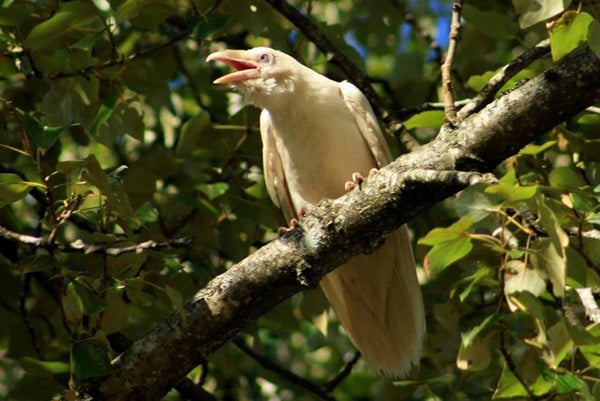
Note that Jasper is leucistic, not an albino. Albinos lack melanin entirely, including in their internal organs. Leucistic animals don’t lack pigment but, rather, have their pigments expressed in reduced form, apparently in their integument alone. They therefore tend to be creamy or yellowish, not pure white, and the fact that their internal membranes and so on are pigmented means that they aren’t as negatively affected by their condition as albinos are. Note that Jasper’s bill and feet have a ‘washed out’ look but are not really white.
On supporting science journalism
If you're enjoying this article, consider supporting our award-winning journalism by subscribing. By purchasing a subscription you are helping to ensure the future of impactful stories about the discoveries and ideas shaping our world today.

Gary tells me that leucistic Ravens are relatively common along the east coast of Vancouver Island with many similar individuals having been reported over the years. Ravens are long-lived (10-20 years is typical in the wild, but ages much greater are possible, as evidenced by captive birds that are over 60 years old), so many of the sightings that have been reported are likely of the same individuals. Even so, some or many birds are involved.
Albino and leucistic animals are historically seen as intriguing abnormalities, sometimes having a special cultural significance to local people. Their comparative rarity is well known, as is the fact that the odds are typically stacked against their survival given that they’re not as good at hiding from predators as are normally hued individuals (but read on).
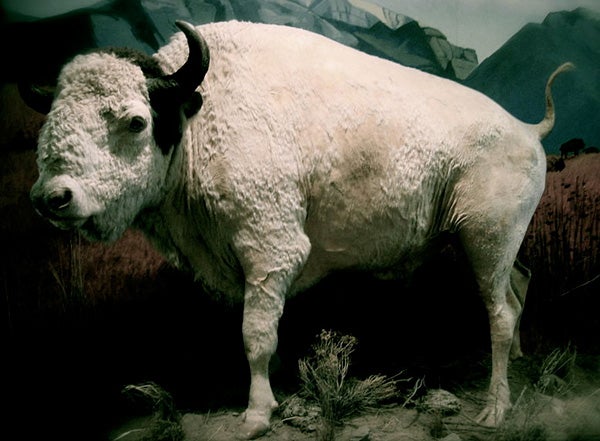
It's well known that white Bison have a special significance, typically been deemed sacred, to local people. This is Big Medicine, a Bison who died in 1959 and is today curated at the Montana Historical Society Museum. Image by W & J, CC BY-SA 3.0.
Birds like Ravens face an additional problem: note how frayed and worn Jasper’s feathers look. As is now fairly well known (I recall when this was an obscure bit of knowledge), melanin granules impart mechanical strength to feathers (and presumably to other biological structures too). This might help explain why birds of so many kinds tend to have evolved dark wingtips (though note that a role in signalling likely contributes to this as well). Of course, this potential use of melanin as a ‘strengthener’ isn’t a hard rule, since there are other birds with completely white wingtips (examples: Glaucous gull Larus hyperboreus, Ivory gull Pagophila eburnea). But the phenomenon in general is nicely displayed by the differential wear that occurs in bird wingtips and on certain two-toned feathers: look at this illustration (from Strauch 1991) to see how the white tips of Herring gull L. argentatus wing feathers and brown edges of Snow bunting Plectrophenax nivalis feathers are worn away during the year, the black parts remaining behind.
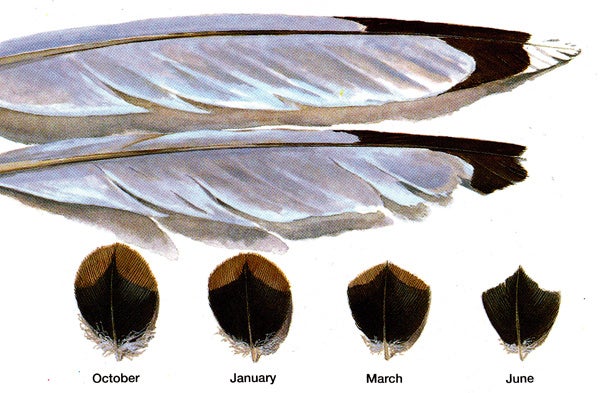
Differential erosion in feathers, illustrated in Strauch (1991). The black parts of feathers are stronger than the pale or white parts.
Presumably, then, a massively reduced amount of melanin explains the rather poor condition of Jasper’s feathers. Does this affect Jasper’s flight ability, the insulative qualities of Jasper’s feathers, or Jasper’s ability to be showy and procure a mate? Those are all good questions and I don’t know if we have the answers.
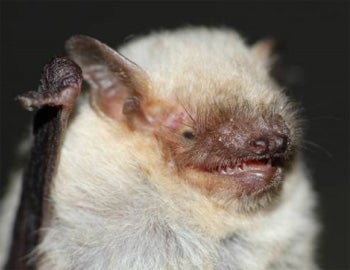
If you're a leucistic bat (like this pipistrelle), it might not matter. Photo from Baucells et al. (2013).
Is being pale always bad? In short, it really looks likely that the recessive genes resulting in leucism are detrimental. Or, are normally detrimental… it’s not difficult to imagine evolutionary scenarios whereby increased whiteness would be advantageous: white corvids that take to foraging in snowy or icy habitats might be advantaged, and there have been occasional suggestions that unusually white animals are advantaged when living alongside people. They receive preferential treatment and tend not to be hit by cars or killed by hunters. And there’s already some work showing that, in some animals (bats are a good example), reduced pigmentation may not have any effect on survival, or might even be advantageous (Baucells et al. 2013), perhaps for thermoregulatory or signalling reasons.
Melanin in some animals is linked with aggression* (Rushton & Templer 2012). Given that selection operates in different ways in different communities at different times, there are surely occasions where a reduced level of aggression could well be selectively advantageous when it comes to the survival of offspring (say, in a crowded nesting colony).
* Incidentally, there’s a ton of stuff online about how melanin in humans is linked with intelligence – the so-called ‘melanin theory’. It appears to be racist pseudoscience.
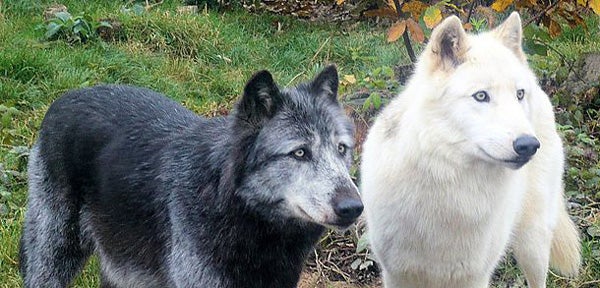
Melanism in some (many?) animals really is linked with a propensity for aggression. But does this mean that being devoid of melanin is always bad? Captive wolves, image by Stéfan, CC BY 2.0.
Furthermore, I’ve already mentioned the expectation that unusually pigmented individuals are preferentially picked off by predators. While there’s some experimental support for this apparently sensible hypothesis (e.g., Mueller 1975) there’s a lot of anecdotal evidence against it, and it might not always be true, at least not all of the time in all animals. Indeed, it seems that unusually pigmented individuals are seemingly avoided or ignored as potential prey in cases, apparently because they’re novel or unfamiliar to the predators concerned (remember that predators are often conservative, sticking with what they know). A case study concerns Götmark’s (1997) work on Eurasian magpie Pica pica coloration: an aberrant brown magpie seemed to be at reduced predation risk from Goshawks Accipiter gentilis due to its novelty.
.jpg?w=600)
Cropped version of image used above - note the frayed feathers. Pic by Scott Crawford, used with permission.
As always, there’s more to say. Pale or white crows are especially unusual given the fact that they belong to a group where overall blackness is of course such a significant and obvious thing, a fact which raises the question as to why crows are so overwhelmingly black in the first place. And I remain intrigued by Jasper’s frayed, decayed-looking feathers… I’ll say silky feather mutation and leave it at that.
For previous Tet Zoo articles on corvids and feathers and other topics mentioned here, see...
The snood of the turkey, the wires and rackets of the motmot, the face of the rook
Petrels: some form-function rules , and pattern and pigmentation (petrels part III)
My local magpie family: four weeks of observation, 265 photos, and how good are the results?
Refs - -
Götmark, F. 1997. Bright plumage in the magpie: does it increase or reduce the risk of predation? Behavioral Ecology and Sociobiology 40, 41-49.
Mueller, H. C. 1975. Hawks select odd prey. Science 88, 953-954.
Rushton, J. P. & Templer, D. I. 2012. Do pigmentation and the melanocortin system modulate aggression and sexuality in humans as they do in other animals? Personality and Individual Differences 53, 4-8.
Strauch, 1991. Feathers. In Brooke, M. & Birkhead, T. (eds) The Cambridge Encyclopedia of Ornithology. Cambridge University Press (Cambridge), pp. 20-26.